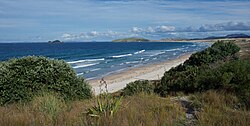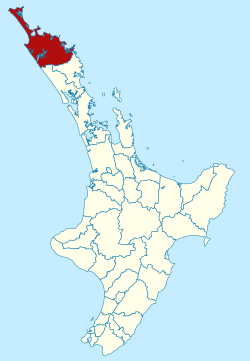35°13′30″S 173°30′18″E / 35.225°S 173.505°E / -35.225; 173.505
Territorial authority district in Northland Region, New Zealand| Far North District Te Hiku o te Ika | |
|---|---|
| Territorial authority district | |
 | |
 Far North district within the North Island Far North district within the North Island | |
| Country | New Zealand |
| Region | Northland Region |
| Wards | Te Hiku Bay of Islands-Whangaroa Bay of Islands-Whangaroa Ngā Tai o Tokerau (Māori) |
| Seat | Kaikohe |
| Government | |
| • Mayor | Moko Tepania |
| • Territorial authority | Far North District Council |
| Area | |
| • Total | 7,323.86 km (2,827.76 sq mi) |
| • Land | 6,686.61 km (2,581.71 sq mi) |
| Population | |
| • Total | 74,700 |
| • Density | 10/km (26/sq mi) |
| Time zone | UTC+12 (NZST) |
| • Summer (DST) | UTC+13 (NZDT) |
| Postcode(s) | Map of postcodes |
| Area code | 09 |
| Website | FNDC.govt.nz |
The Far North District is the northernmost territorial authority district of New Zealand, consisting of the northern part of the Northland Peninsula in the North Island. It stretches from North Cape / Otou and Cape Reinga / Te Rerenga Wairua in the north, down to the Bay of Islands, the Hokianga and the town of Kaikohe.
The Far North District Council is based in Kaikohe, and has ten ward councillors representing four wards: Te Hiku (in the north), Kaikohe-Hokianga (in the west), Bay of Islands-Whangaroa (in the east) and the district-wide Ngā Tai o Tokerau Māori ward. The council is led by the current mayor of Far North, Moko Tepania, who entered the role in 2022.
Geography

The Far North District is the largest of three territorial authorities making up the Northland Region. The district stretches from the capes and bays at the northern tip of the Aupōuri Peninsula past Te Oneroa-a-Tōhe / Ninety Mile Beach to the main body of the Northland Peninsula, where it encompasses the Parengarenga Harbour, Whangaroa Harbour and Bay of Islands (on the east coast) and Hokianga (on the west coast).
It borders on the Kaipara and Whangarei Districts, which are the other two territorial authorities in the Northland Region.
Population
Far North District covers 6,686.61 km (2,581.71 sq mi) and had an estimated population of 74,700 as of June 2024, with a population density of 11.2 people per km.
| Year | Pop. | ±% p.a. |
|---|---|---|
| 2006 | 55,845 | — |
| 2013 | 55,734 | −0.03% |
| 2018 | 65,250 | +3.20% |
| 2023 | 71,430 | +1.83% |
| Source: | ||
Far North District had a population of 71,430 in the 2023 New Zealand census, an increase of 6,180 people (9.5%) since the 2018 census, and an increase of 15,696 people (28.2%) since the 2013 census. There were 35,529 males, 35,709 females and 192 people of other genders in 26,049 dwellings. 2.1% of people identified as LGBTIQ+. The median age was 44.3 years (compared with 38.1 years nationally). There were 14,193 people (19.9%) aged under 15 years, 10,914 (15.3%) aged 15 to 29, 30,588 (42.8%) aged 30 to 64, and 15,735 (22.0%) aged 65 or older.
People could identify as more than one ethnicity. The results were 64.6% European (Pākehā); 49.9% Māori; 5.4% Pasifika; 3.2% Asian; 0.6% Middle Eastern, Latin American and African New Zealanders (MELAA); and 2.0% other, which includes people giving their ethnicity as "New Zealander". English was spoken by 96.8%, Māori language by 15.6%, Samoan by 0.4% and other languages by 6.0%. No language could be spoken by 1.9% (e.g. too young to talk). New Zealand Sign Language was known by 0.6%. The percentage of people born overseas was 15.3, compared with 28.8% nationally.
Religious affiliations were 32.4% Christian, 0.5% Hindu, 0.2% Islam, 5.9% Māori religious beliefs, 0.4% Buddhist, 0.5% New Age, 0.1% Jewish, and 1.1% other religions. People who answered that they had no religion were 51.4%, and 7.9% of people did not answer the census question.
Of those at least 15 years old, 6,780 (11.8%) people had a bachelor's or higher degree, 31,995 (55.9%) had a post-high school certificate or diploma, and 16,353 (28.6%) people exclusively held high school qualifications. The median income was $29,700, compared with $41,500 nationally. 3,126 people (5.5%) earned over $100,000 compared to 12.1% nationally. The employment status of those at least 15 was that 22,947 (40.1%) people were employed full-time, 7,950 (13.9%) were part-time, and 2,670 (4.7%) were unemployed.
| Name | Area (km) |
Population | Density (per km) |
Dwellings | Median age | Median income |
|---|---|---|---|---|---|---|
| Te Hiku General Ward | 2,326.32 | 22,740 | 9.8 | 8,358 | 42.6 years | $28,600 |
| Bay of Islands-Whangaroa General Ward | 2,088.23 | 33,045 | 15.8 | 12,537 | 47.2 years | $33,200 |
| Kaikohe-Hokianga General Ward | 2,272.06 | 15,645 | 6.9 | 5,154 | 39.1 years | $26,600 |
| New Zealand | 38.1 years | $41,500 |
Urban areas and settlements

The Far North District has eight towns with a population over 1,000. Together they are home to 36.9% of the district's population.
| Urban area | Population
(June 2024) |
% of district |
|---|---|---|
| Kerikeri | 8,360 | 11.2% |
| Kaitaia | 6,380 | 8.5% |
| Kaikohe | 4,890 | 6.5% |
| Moerewa | 2,100 | 2.8% |
| Paihia | 1,690 | 2.3% |
| Kawakawa | 1,630 | 2.2% |
| Opua | 1,290 | 1.7% |
| Haruru | 1,230 | 1.6% |
The northernmost town in the district is Kaitaia. Kerikeri, Moerewa, Kawakawa, Paihia, Opua and Russell are clustered on the east coast around the Bay of Islands with Kaikohe centrally situated to their west. Another cluster of small settlements, Ōmāpere, Opononi, Rawene, Panguru, Kohukohu, and Horeke, surrounds the Hokianga Harbour on the west coast.
References
- ^ "Aotearoa Data Explorer". Statistics New Zealand. Retrieved 26 October 2024.
- "About Far North District Council". fndc.govt.nz. Far North District Council.
- de Graaf, Peter (14 October 2022). "Moko Tepania makes history as Far North's new mayor". The Northern Advocate. New Zealand Herald.
- "ArcGIS Web Application". statsnz.maps.arcgis.com. Retrieved 9 October 2024.
- ^ "Totals by topic for individuals, (RC, TALB, UR, SA3, SA2, Ward, Health), 2013, 2018, and 2023 Censuses". Stats NZ - Tatauranga Aotearoa - Aotearoa Data Explorer. Far North District (001). Retrieved 3 October 2024.
- "Statistical area 1 dataset for 2018 Census". Statistics New Zealand. March 2020. Far North District (001). 2018 Census place summary: Far North District
- "Totals by topic for dwellings, (RC, TALB, UR, SA3, SA2, Ward, Health), 2013, 2018, and 2023 Censuses". Stats NZ - Tatauranga Aotearoa - Aotearoa Data Explorer. Retrieved 3 October 2024.
- "Totals by topic for individuals, (RC, TALB, UR, SA3, SA2, Ward, Health), 2013, 2018, and 2023 Censuses". Stats NZ - Tatauranga Aotearoa - Aotearoa Data Explorer. Te Hiku General Ward. Retrieved 3 October 2024.
- "Totals by topic for individuals, (RC, TALB, UR, SA3, SA2, Ward, Health), 2013, 2018, and 2023 Censuses". Stats NZ - Tatauranga Aotearoa - Aotearoa Data Explorer. Bay of Islands-Whangaroa General Ward. Retrieved 3 October 2024.
- "Totals by topic for individuals, (RC, TALB, UR, SA3, SA2, Ward, Health), 2013, 2018, and 2023 Censuses". Stats NZ - Tatauranga Aotearoa - Aotearoa Data Explorer. Kaikohe-Hokianga General Ward. Retrieved 3 October 2024.
External links
| Adjacent cities and districts | ||||||||||||||||
|---|---|---|---|---|---|---|---|---|---|---|---|---|---|---|---|---|
| ||||||||||||||||
| Cities and districts of New Zealand | |||||
|---|---|---|---|---|---|
| Cities |
| ||||
| Districts |
| ||||
| Other | Chatham Islands | ||||